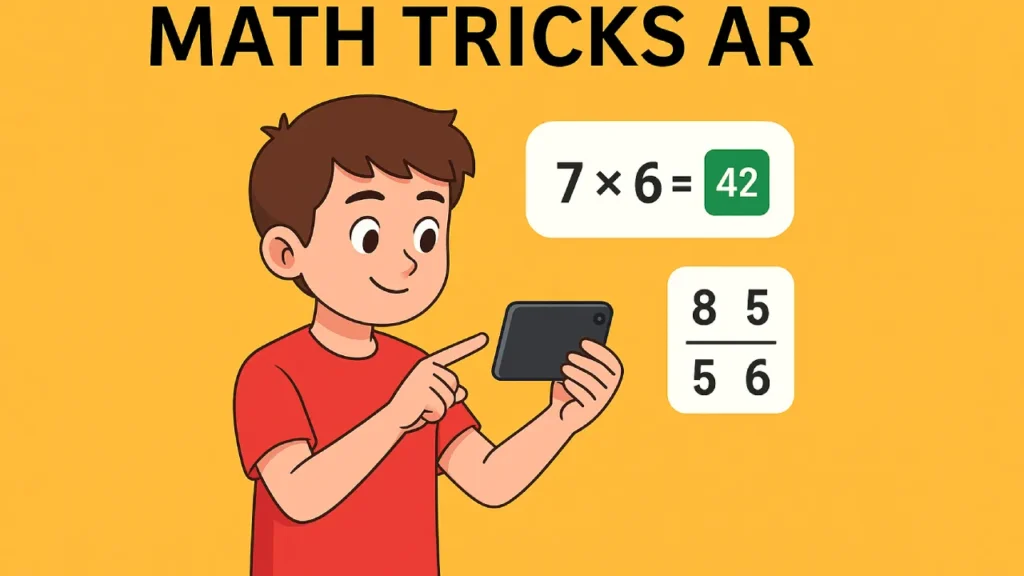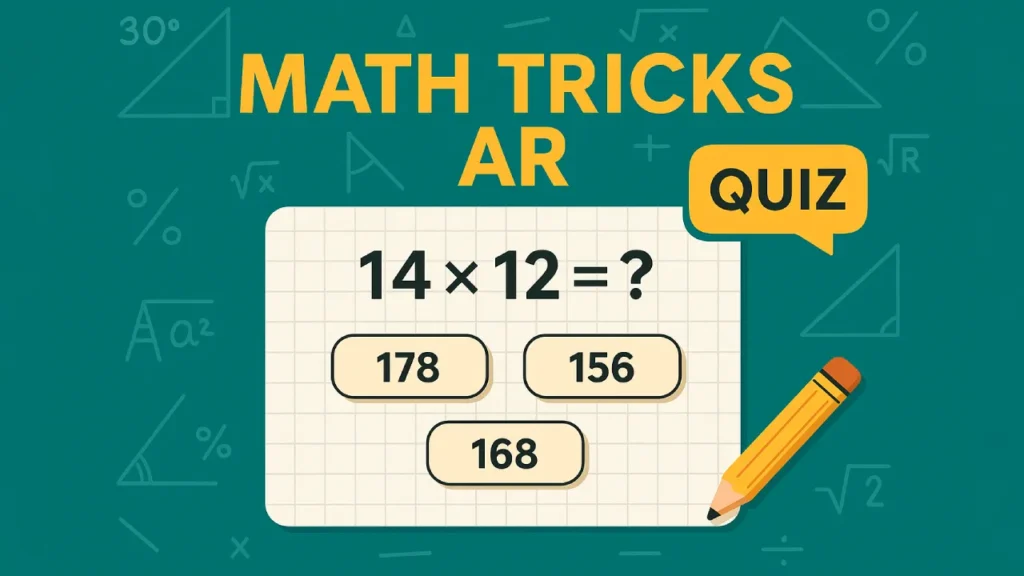
Mathematics doesn’t have to be boring. For generations, students have feared numbers, equations, and formulas, but what if math could become fun, fast, and fascinating? Math Tricks by Antoni Soft Group is a revolutionary math learning app designed to make you fall in love with numbers again.
Whether you’re a student preparing for exams, a professional who wants to sharpen mental agility, or simply someone who enjoys problem-solving, this app helps you boost your calculation speed and develop strong math skills through smart arithmetic shortcuts and interactive training.
Why Learning Math Tricks Matters
In today’s fast-paced world, quick mental calculation is more than a classroom skill; it’s a life skill. From managing money and checking bills to solving competitive exam questions, math plays a crucial role everywhere.
Learning mental math tricks helps you:
Calculate faster without a calculator.
Improve focus and logical reasoning.
Build confidence in number sense.
Save precious time in competitive exams like the SAT, GRE, GMAT, and government tests.
Make daily tasks, such as budgeting or tipping, quicker and easier.
This is where the Math Tricks app changes the game. It doesn’t just teach, it trains your brain to think faster and smarter.
About the Math Tricks App
Developed by Antoni Soft Group, the Math Tricks app is a fun and educational program designed for anyone looking to speed up calculations using simple, effective math techniques.
The app has garnered over 10 million downloads and boasts an impressive 4.4-star rating on Google Play, making it one of the most popular brain-training math apps worldwide.
App Highlights:
User-friendly design with colorful graphics
84+ math tricks covering all major arithmetic operations
15 levels per trick to strengthen your calculation ability
Timer-based challenges that improve focus and speed
Star rating system to track your performance
Step-by-step explanations that show how and why each trick works
With each lesson, you learn not only the shortcut but also the logic behind it, ensuring long-term understanding and practical application.
Fun Math Tricks You’ll Learn

In this section, each trick has a brief introduction, followed by a step-by-step guide with examples. Use transition words like ‘first,’ ‘next,’ and ‘finally to maintain the flow.
1. Multiply by 11 — the “insert sum” trick
Here’s a trick you can do in your head with two digits:
Steps:
- Suppose you want 47 × 11.
- Take the two digits: 4 _ 7.
- Insert between them the sum: 4 (4+7) 7 = 4 11 7.
- But 11 is two digits, so carry: 4 + 1 carry = 5, then 1, then 7 → 517.
- So 47 × 11 = 517.
You try: 65 × 11 → 6 (6+5) 5 = 6 11 5 → carry → 715.
This is one of the simplest multiplication shortcuts you’ll memorize.
2. Multiply near base (e.g., 98 × 97)
If numbers are close to a round base like 100:
Steps:
- Write each as (base − deficit). So 98 = 100 − 2, 97 = 100 − 3.
- Multiply deficits: 2×3 = 6 → that’ll be the “last part”
- Cross subtract: 98 − 3 = 95 (or 97 − 2) → that’s the “first part”
- Combine: 95 | 06 → 9506.
So 98 × 97 = 9506 in your head. Try 103 × 107 similarly (with surplus).
3. Squaring numbers ending in 5
For any number ending in 5, say 75²:
Steps:
- Remove the 5: that gives 7
- Multiply 7 × (7 + 1) = 7 × 8 = 56
- Append “25” at the end → 5625
So 75² = 5625.
Try with 85² → 8 × 9 = 72 → then append 25 → 7225.
4. Divisibility rules cheat sheet
These are short, powerful rules:
- Divisible by 3: sum of digits divisible by 3
- Divisible by 9: sum of digits divisible by 9
- Divisible by 11: alternating sum difference is 0 or a multiple of 11
- Divisible by 7 (harder) — use the trick of doubling the last digit and subtracting.
Because you’ve got divisibility tricks, you can avoid brute division mentally.
5. Complements to 10 or 100 (for fast subtraction)
When subtracting, convert to the nearest round:
Example: 1000 − 378
Think: 1000 − 400 = 600 → then add back 22 = 622
Or complement method: 378 complements to 1000 is 622 (i.e., what you add to 378 to get 1000).
Advanced Systems: Vedic, Trachtenberg & Abacus
Now you shift from cute hacks to full systems you can train. Yes, the payoff is bigger, but you’ll have to put in the practice.
Vedic Math (Vertical & Crosswise)
The Vedic mathematics system is an ancient set of sutras (aphorisms) that let you compute large multiplications, divisions, squares, and roots with surprising speed. You’ll often see the formula used vertically and crosswise, a method that generalizes multiplication across digits. With consistent practice, Vedic math tricks enable you to perform 4-digit × 4-digit multiplication on paper or in your head with fewer steps than traditional long multiplication.
How it works (example):
Suppose you want 23 × 45.
- Write vertically: (2 3) × (4 5)
- You compute crosswise:
* 2 × 4 (leftmost)
* (2 × 5 + 3 × 4) (middle cross)
* 3 × 5 (rightmost) - You combine with carries.
You can view a worked example on the Vedic Maths official website.
(If you want a full list of sutras and examples beyond this, I can expand.)
Trachtenberg Method
Intro:
Developed by Jakow Trachtenberg in the 20th century, this Trachtenberg system breaks multiplication and division into repeated simple steps and additive shortcuts. It’s less “magical trick” and more “algorithm you memorize and apply.” Professionals use it in speed math contests.
Example snippet (multiplying by 12):
- Multiply the number by 10 (i.e., shift left)
- Add twice the number (because 12 = 10 + 2)
- Adjust carries
So 123 × 12 = 1230 + 246 = 1476.
The power: once you get the pattern, you can do more complex steps. (Dive into Trachtenberg method resources to see full tables.)
Abacus / Soroban & Mental Imagery
Learning the abacus (or Japanese Soroban) trains your mind to visualize beads, carry over, and perform subtraction/addition in your head as if manipulating physical beads. Many mental math champions begin by mastering the abacus and then switch to purely mental (no beads).
How to start (suggested steps):
- Learn bead layout and place values.
- Practice addition/subtraction with beads
- Transition to visualizing the beads “mental abacus”
- Combine with other tricks (e.g., crosswise multiplication)
Training with an abacus builds speed and error resilience.
Step-by-Step Practice Plan (30 Days to Speed)
Here’s how you can go from 0 to mental math speedster. Use this schedule and repeat.
| 1–3 | Fundamentals | Practice addition/subtraction mentally up to 3 digits |
| 4–6 | Multiplication hacks | Use multiply by 11, square ending 5, base tricks |
| 7–10 | Divisibility & complements | Quiz yourself on divisibility by 3, 9, 11 |
| 11–15 | Vedic / crosswise practice | Use a physical/virtual abacus and then visualize |
| 16–20 | Trachtenberg modules | Learn simple multiplication by 12, 6, 7, etc. |
| 21–25 | Abacus transitions | Use physical/virtual abacus and then visualize |
| 26–30 | Mixed drills | Combine everything under time limits |
Each day, do 20 problems in 10 minutes. Track your time. Challenge yourself week to week. You’ll start catching patterns fast (yes, you will).
Gamified Learning Experience
One of the best things about the Math Tricks app is its gamified training system. Each mathematical trick comes with 15 progressive levels and a 15-second timer, testing your speed and accuracy.
What Users Love About Math Tricks
With over 417,000 reviews, users worldwide praise Math Tricks for its simplicity, effectiveness, and fun approach to mathematics. Some feedback includes:
“It doesn’t just give the trick, it explains the reasoning behind it.”
“Perfect app for improving speed in math tests.”
“Fewer ads than most apps, and totally free!”
“My mental math skills improved dramatically in a few weeks.”
Students, teachers, and parents recommend it as a must-have educational app for anyone who wants to make math easier and faster.
Technology Behind Math Tricks
Math Tricks is built using modern Android APIs and libraries for smooth performance and clean visuals:
MPAndroidChart by Philipp Jahoda for clear data visualization and progress graphs
Color Picker by Piotr Adamus for customizable and engaging design
Its clean UI, fast response, and low resource usage make it ideal for Android version 5.0 and up. It’s limited offline mode lets learners practice math anywhere on the go, in class, or at home.
Download & Resource Guide
To help you get started with printable sheets, cheat sheets, and more structured materials, click the link below to go to my download page:
Download Page → Click Here
You’ll find PDFs, worksheet collections, and drills to support your daily training.
FAQ
Q: How fast can I realistically get?
If you stick with the 30-day plan and practice daily, you could reduce computation times by 50% or more. Some users reach 3-digit × 3-digit in ~10–15 seconds.
Q: Should I memorize all tables first?
Yes, you need multiplication tables up to 12×12 solidly. Tricks build on that foundation.
Q: Mistakes will happen — how to reduce them?
Always check via reverse (e.g., if you compute A × B = C, you can divide C / A to see if you get B). Slow down early; accuracy is more important than speed initially.
Q: Which trick should I learn first?
Start with multiplying by 11 and square numbers ending in 5, as they deliver fast wins and motivate you.
Conclusion
Math Tricks makes mathematics intuitive, fast, and fun. With logic-based shortcuts, interactive levels, and gamified challenges, it helps users of all ages strengthen their mental arithmetic.
Whether you’re practicing for exams or just want to impress your friends with lightning-fast calculations, Math Tricks is a must-have app. Try it today and see how easy math can become.


